Robotic Process Automation Basics in 2024 emphasizes the growing trends in software development and startups, particularly in streamlining processes and increasing efficiency. As businesses seek innovative solutions to optimize their operations, robotic process automation (RPA) is a transformative technology that automates repetitive tasks. This innovative technology enhances efficiency and productivity while minimizing human intervention.
Aloa, an expert in software outsourcing, acknowledges the crucial role of RPA in revolutionizing business operations. With its wide range of applications, including business process automation, customer service optimization, and financial services, RPA proves invaluable in driving innovation and competitiveness. Their expertise aligns with using RPA to optimize business process management and enhance data management.
This blog gives you comprehensive insights into Robotic Process Automation basics, RPA applications across various industries, and how to leverage RPA effectively. Before implementing this emerging technology in your business, we will also explore the essential considerations. Afterward, you will gain a thorough understanding of RPA concepts, its integration with artificial intelligence, and practical use cases.
Explore the potential of RPA in enhancing your business processes and staying ahead in the digital transformation. Let's get started!
What Is Robotic Process Automation Basics
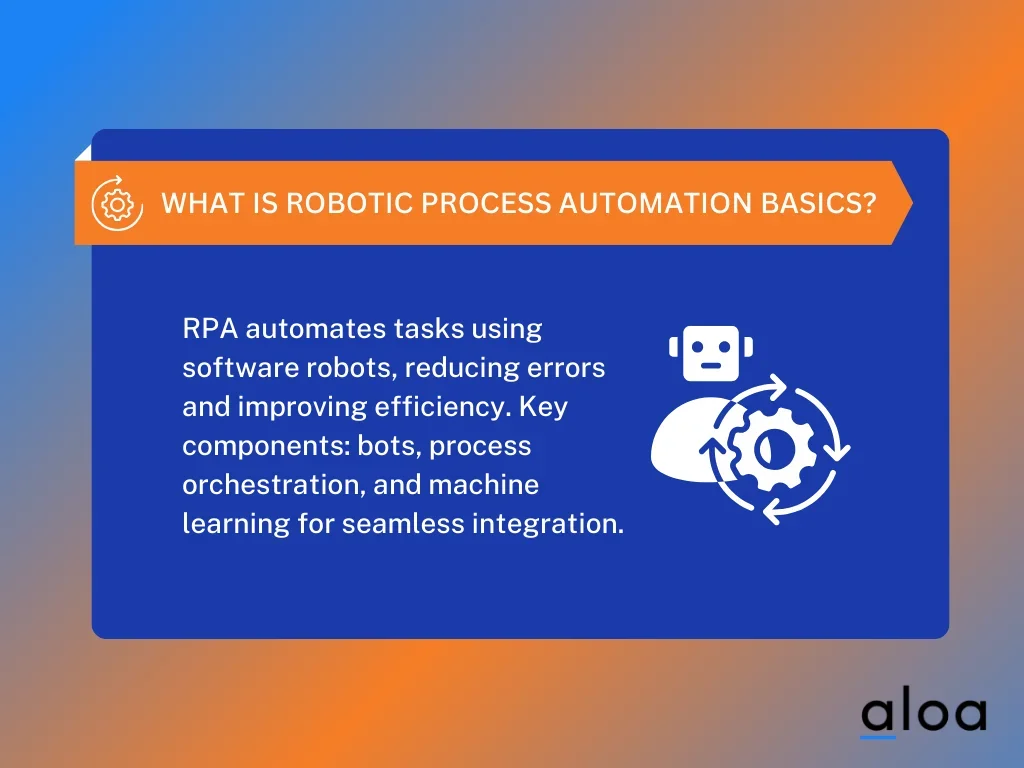
Robotic Process Automation basics involve using software robots to automate repetitive tasks. It encompasses vital components such as bots, process orchestration, and machine learning to streamline manual tasks and enhance efficiency within various industries. By automating routine tasks, RPA software reduces human error and ensures regulatory compliance.
Here are the key components of RPA:
- Bots: Software robots programmed to execute manual tasks.
- Process Orchestration: Coordination of automated workflows.
- Machine Learning: Integration of AI to improve automation accuracy and adaptability.
RPA tutorial resources and top RPA tools facilitate the implementation of RPA software, enabling organizations to automate processes across legacy systems and IT infrastructure. It enables organizations to integrate automation processes seamlessly into their existing IT infrastructure, even with legacy systems. RPA examples encompass various industries, including supply chains, call centers, and data analytics. Pilot projects demonstrate the potential of RPA in completing complex tasks, such as process mining and image recognition.
How To Leverage Robotics Process Automation in 2024
In 2024, leveraging robotics process automation basics can significantly enhance efficiency and streamline operations for businesses and startups. Here are seven steps to effectively harness the power of RPA:
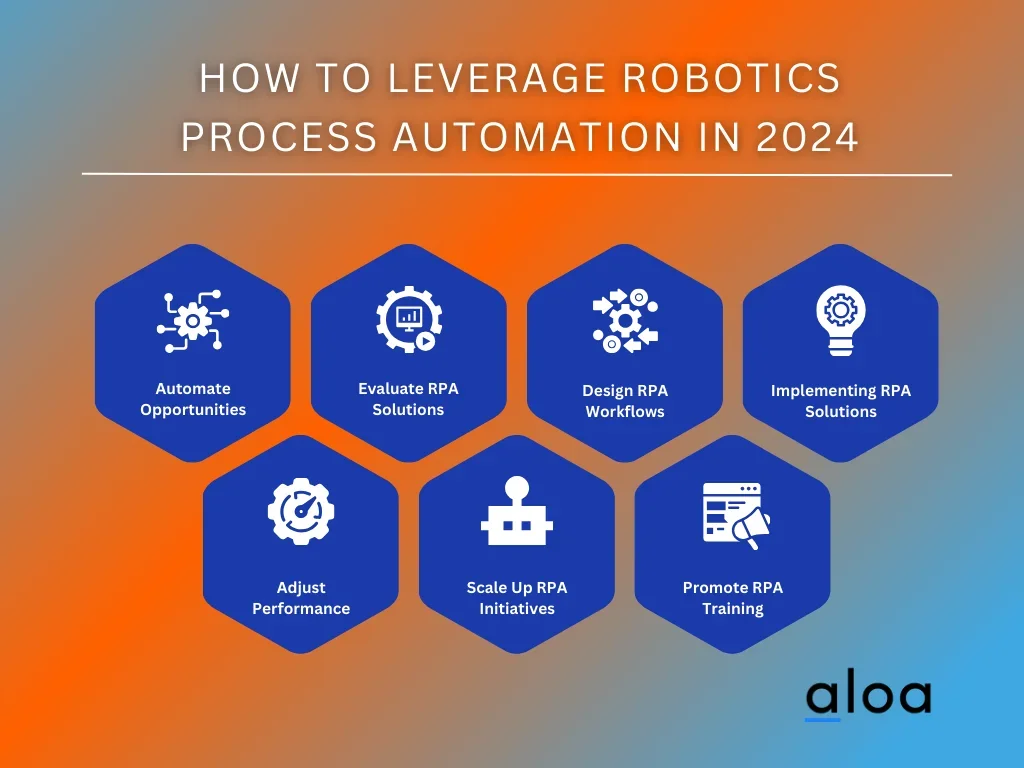
Step 1: Identify Opportunities for Automation
The initial phase in harnessing Robotic Process Automation basics involves pinpointing automation prospects within your organization. This necessitates scrutinizing current processes and workflows to pinpoint repetitive, rule-based tasks suitable for automation. Highlight tasks consuming substantial time and susceptible to human error, as these represent prime candidates for RPA implementation. Consider these key questions:
- Which processes within your organization are repetitive and rule-based?
- Are there tasks that consume a significant amount of time?
- Where are the areas prone to human error that could benefit from automation?
Identifying these opportunities lays the groundwork for successful RPA integration, streamlining operations, and enhancing efficiency within your organization. By effectively identifying automation opportunities, businesses can pave the way for successful implementation of robotic process automation, achieving improved productivity and reduced operational costs.
Step 2: Evaluate RPA Solutions
After pinpointing areas for automation, the crucial next step is to assess RPA solutions suitable for your organization's requirements. Begin by scrutinizing factors like scalability, ease of implementation, and compatibility with current systems. Seek out RPA platforms boasting a user-friendly interface, robust functionality, and comprehensive support services. Here are some key considerations:
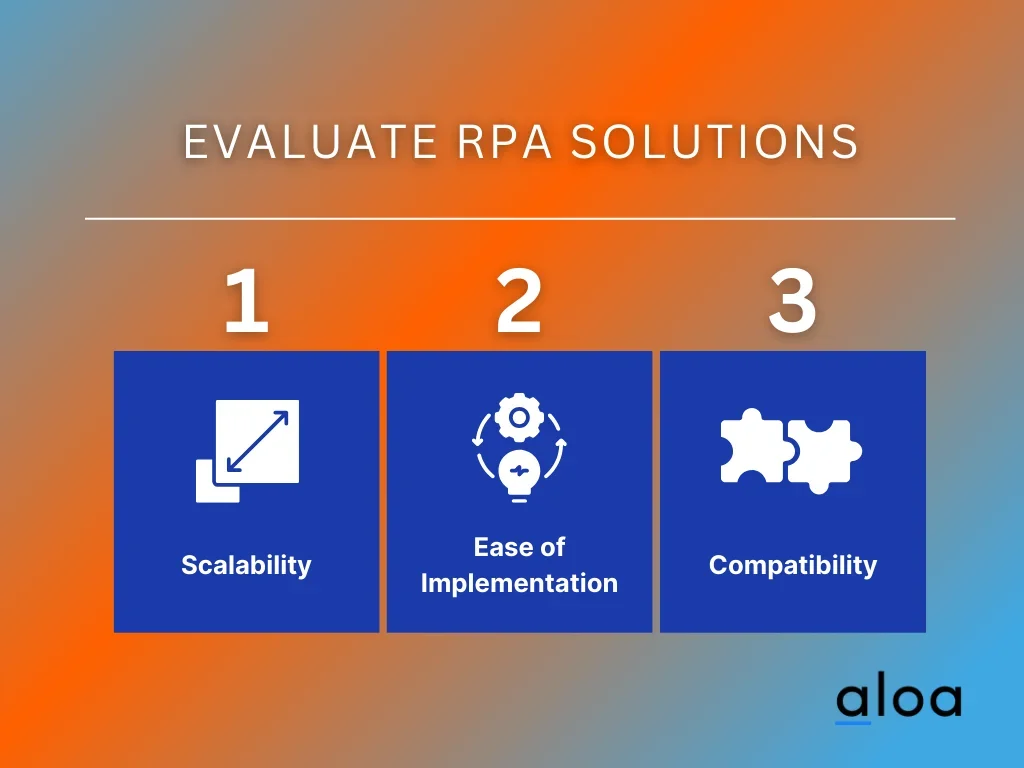
- Scalability: Ensure the chosen RPA solution can scale alongside your organization's growth.
- Ease of Implementation: Look for platforms that streamline the implementation process, minimizing disruption to existing operations.
- Compatibility: Verify compatibility with your organization's existing systems to facilitate seamless integration.
Selecting the right RPA solution is pivotal for successful automation initiatives. By carefully evaluating various platforms based on scalability, implementation ease, and compatibility, organizations can ensure optimal outcomes from their RPA endeavors.
Step 3: Design RPA Workflows
Now that you've chosen the appropriate RPA solution, crafting RPA workflows tailored to your organization's needs is crucial. Collaborate closely with your team to meticulously outline each step of the processes earmarked for automation. Utilize this opportunity to pinpoint areas ripe for enhancement and efficiency boosts. Ensure that the designed RPA workflows exhibit adaptability, scalability, and simplicity in maintenance. Here are some considerations for designing RPA workflows:
- Ensure alignment of RPA workflows with overarching business objectives.
- Incorporate feedback from end-users to optimize workflow design.
- Regularly review and update RPA workflows to accommodate evolving business needs.
Crafting well-designed RPA workflows is a pivotal step towards harnessing the full potential of Robotic Process Automation basics. By investing time and effort in this phase, organizations can pave the way for smoother, more efficient processes that drive productivity and innovation.
Step 4: Implementing RPA Solutions
After meticulously designing your RPA workflows, the next crucial step is the implementation of Robotic Process Automation basics solutions. Collaborate closely with your IT team or chosen RPA vendor to deploy the RPA software within your organization seamlessly. Ensure the RPA solution is configured accurately to align with your company's unique processes and objectives.
Additionally, provide comprehensive training to your team members on efficiently utilizing the RPA software, emphasizing the transformative benefits of automation. By effectively implementing RPA solutions, you can streamline operations, enhance productivity, and unlock new opportunities for innovation and growth.
Step 5: Monitor Performance and Make Adjustments
Once Robotic Process Automation basics have been implemented, monitoring their performance and actively making necessary adjustments is imperative. Start by tracking essential metrics such as process efficiency, error rates, and cost savings to gauge the effectiveness of RPA within your organization. This allows you to quantify the impact of RPA and identify areas for improvement.
Identify any bottlenecks or issues that may arise during the automation process. By addressing these issues promptly, you can ensure smooth operations and maximize the benefits of RPA. Continuously optimizing your Robotic Process Automation basics workflows based on performance data and user feedback ensures that your automation processes remain efficient and aligned with organizational goals. Regular monitoring and adjustment are essential for maintaining the success of RPA initiatives in the long term.
Step 6: Scale Up RPA Initiatives
As your organization acquires Robotic Process Automation basics and experiences its advantages, it's time to expand your RPA initiatives. Begin by pinpointing more processes and workflows suitable for automation through RPA, leveraging the foundation you've already established. Continuously seek out areas where RPA can streamline operations and increase efficiency. Here are some considerations for scaling up RPA initiatives:
- Identify additional processes ripe for automation.
- Integrate RPA with AI and machine learning.
- Explore opportunities for advanced automation.
Explore opportunities to integrate Robotic Process Automation basics with cutting-edge technologies like artificial intelligence and machine learning to amplify automation capabilities. By scaling up your RPA endeavors strategically, you can unlock even more significant potential for innovation and optimization within your organization, propelling it toward higher levels of productivity and competitiveness in today's dynamic business landscape.
Step 7: Promote RPA Adoption and Training
To ensure the success of your Robotic Process Automation basics initiatives, it's crucial to promote adoption and provide comprehensive training to your team actively. Communicate the significant benefits of RPA to employees across all levels of the organization, emphasizing its potential to streamline operations and boost productivity. Encourage a culture of automation by fostering enthusiasm for RPA and highlighting its potential to augment rather than replace human workers.
Offer tailored training programs to equip employees with the skills and knowledge needed to utilize RPA tools effectively. Provide hands-on experience and practical guidance to ensure employees feel confident implementing automation solutions. By investing in robust training initiatives, you can empower your team to leverage RPA technology to its fullest potential and drive meaningful organizational transformation.
Applications of RPA in 2024
In 2024, Robotic Process Automation basics will continue to revolutionize industries worldwide. This process automation technology has become a cornerstone for businesses seeking to enhance efficiency and streamline operations. Let's delve into the applications of RPA across various sectors:
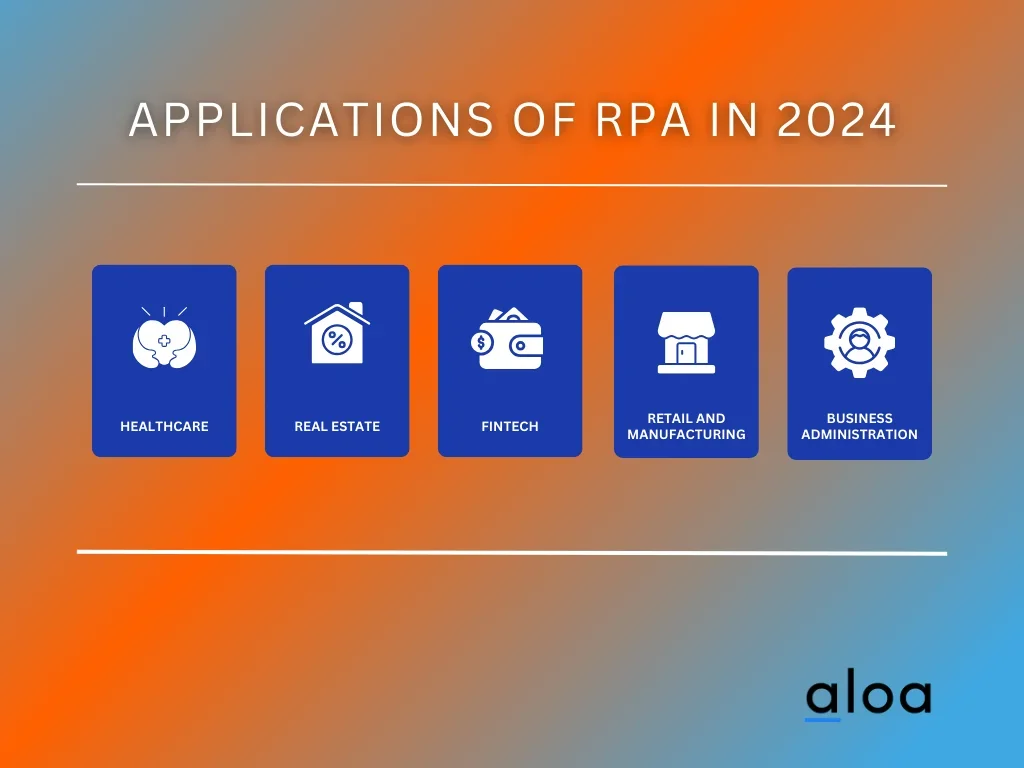
RPA in Healthcare
RPA in Healthcare is pivotal in enhancing patient care and administrative efficiency. Healthcare providers utilize automation software to streamline appointment scheduling, claims processing, and patient record management. RPA enables healthcare professionals to focus more on patient-centric tasks while software bots handle mundane administrative duties. This robotic process automation technology integration has significantly improved healthcare service delivery and patient outcomes.
RPA in Real Estate
RPA in real estate has transformed property management, sales, and customer service processes. Real estate firms utilize RPA bots to automate data analysis, lead generation, and customer communication tasks. Real estate professionals can optimize time management and improve client satisfaction by leveraging software programs to handle repetitive workflows. At the same time, RPA tech like drones can help with infrastructure inspections to determine asset quality. The use of RPA has become fundamental for staying competitive in the dynamic real estate market.
RPA in Business Administration
RPA in Business Administration finds extensive applications in general business administration functions. Organizations employ RPA robots to streamline inventory management, invoice processing, and customer support operations. Automating routine tasks enhances operational efficiency, reduces costs, and allows employees to focus on strategic initiatives. Robotic Process Automation basics have become indispensable for modern businesses seeking to optimize workflows and drive growth.
RPA in FinTech
RPA in FinTech plays a crucial role in driving innovation and improving financial services. Financial technology companies utilize RPA to automate risk assessment, compliance monitoring, and fraud detection processes. By harnessing the power of data science and big data, RPA enables FinTech firms to make data-driven decisions swiftly and accurately. This seamless technology integration enhances operational agility and fosters customer trust in financial services.
RPA in Retail and Manufacturing
RPA in retail enhances inventory management, order fulfillment, and customer service operations. Retailers leverage automation software to automate price monitoring, stock replenishment, and customer inquiries. In the manufacturing industry, RPA is utilized to optimize supply chain management, production scheduling, and quality control processes. Manufacturers deploy RPA robots to automate inventory tracking, order processing, and equipment maintenance tasks.
Considerations To Take When Applying RPA
In Robotic Process Automation basics, navigating through various considerations before diving headfirst into implementation is crucial. These considerations serve as guideposts, ensuring a smoother journey toward leveraging RPA for maximum efficiency and productivity gains.
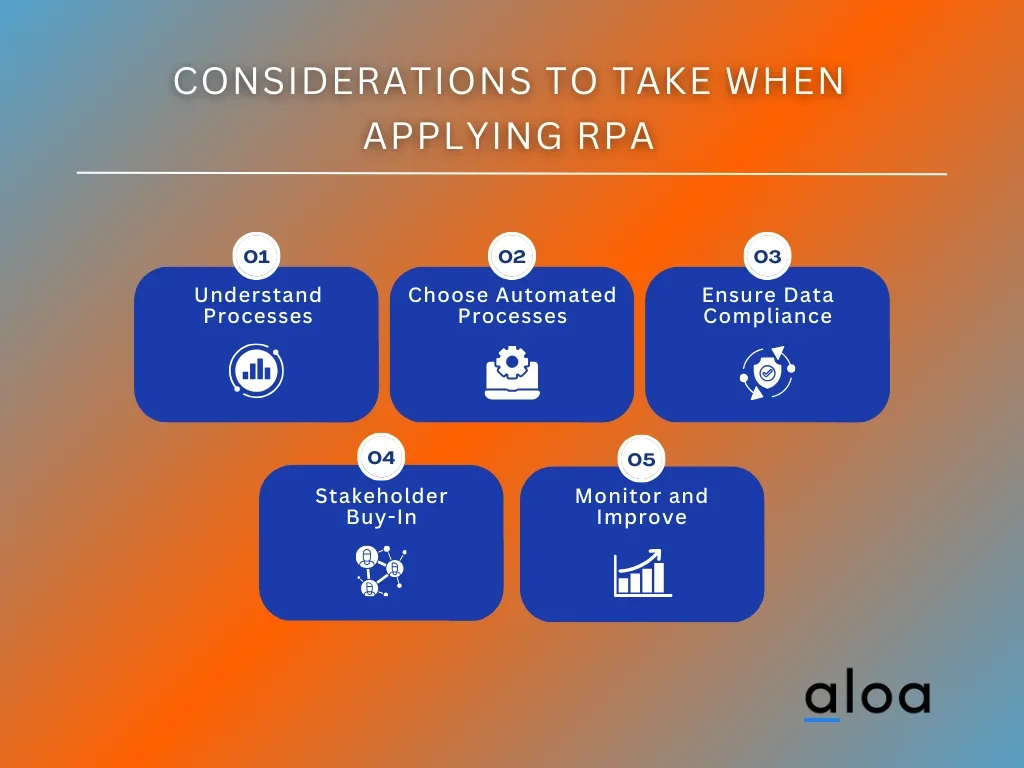
Understand Business Processes
Before implementing RPA, it's imperative to have a deep understanding of existing business processes. This involves identifying repetitive, rule-based tasks that are ripe for automation. Organizations can determine where RPA can make the most significant impact by comprehensively analyzing workflows and identifying pain points. Utilizing Robotic Process Automation basics to automate mundane tasks frees up valuable time and resources, allowing employees to focus on higher-value activities that drive innovation and growth.
Choose the Right Processes for Automation
Organizations must carefully evaluate which processes are best suited for RPA implementation. Highly repetitive, rule-based, and time-consuming tasks are ideal candidates for automation. Conversely, processes that require complex decision-making or human intervention may not yield significant benefits from RPA. Selecting the right processes for automation is critical to ensuring a successful RPA implementation and maximizing ROI.
Ensure Data Security and Compliance
Data security and compliance are crucial concerns with the increasing digitization of business processes. When implementing RPA, organizations must ensure that sensitive data is handled securely and complies with industry regulations. This involves implementing robust security measures, such as encryption and access controls, to safeguard sensitive information. Additionally, organizations must stay abreast of evolving regulatory requirements and ensure their RPA initiatives comply with relevant laws and regulations.
Manage Change and Stakeholder Buy-In
Implementing RPA often entails significant changes to existing workflows and processes. To ensure a smooth transition, organizations must proactively manage change and secure buy-in from key stakeholders. This involves communicating the benefits of RPA and addressing any concerns or reservations that stakeholders may have. By involving stakeholders early in the process and soliciting their input, organizations can foster a sense of ownership and ensure that RPA initiatives are embraced across the organization.
Monitor and Continue Improvement
RPA requires ongoing monitoring and optimization to realize its full potential. Organizations must establish metrics and KPIs to measure the performance and effectiveness of their RPA initiatives. By tracking key metrics such as process efficiency, error rates, and cost savings, organizations can identify areas for improvement and make data-driven decisions to optimize their RPA implementations. Additionally, organizations should foster a culture of continuous improvement, encouraging employees to identify opportunities for further automation and efficiency gains.
Key Takeaway
Robotic Process Automation basics emerge as a crucial tool for developers and startups, offering unparalleled opportunities for streamlining processes and boosting efficiency. By leveraging RPA, businesses can automate repetitive tasks, allowing employees to focus on more strategic initiatives. Whether automating data entry tasks, managing customer inquiries, or handling routine administrative duties, RPA enables organizations to optimize their workflows and drive productivity to new heights.
RPA presents many possibilities for integrating automation into software solutions, enhancing functionality, and delivering seamless user experiences. By incorporating RPA capabilities into their applications, developers can empower users with tools that streamline their workflows and eliminate manual work. Startups, in particular, stand to benefit significantly from embracing RPA technology.
To stay ahead of the curve and capitalize on the opportunities presented by Robotic Process Automation basics, sign up for the email list at Aloa to access our valuable insights on emerging technologies and RPA trends, empowering them to make informed decisions and drive innovation within their organizations.

